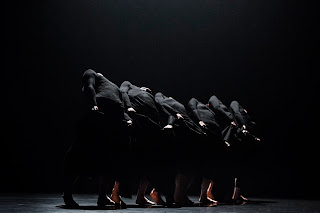解 放 思 想, 破 除 迷 信: Jiefang sixiang, pochu mixin
(Emancipation of thinking and the destruction of superstition)
Sweaping totalitarianism under the rug,
« 6 & 9 », by Tao Dance Theater
Par Luc Archambault
It is always difficult to juge a cultural phenomena outside its context. Art stemming out of China isn’t just art, it’s also a political statement. To be able to survive in the PRC (the People’s Republic of China), one has to adhere rigidly to the party line, hold a philosophical stance in unisson with the Chinese Communist Party’s official guideline. Especially so for artists representing this Behemoth on an international level. Does this diminish the artistic value of any piece of art coming from the PRC ? No, but it sheds a light that should not be dismissed by foreign audiences.
To start this year’s FTA, the Tao Dance Theater, direct from Beijing, was chosen. Why ? Its artistic director, Tao Ye, is a maverick. He's been identified as one of the rising stars of the Chinese stage. Since 2008, he's fascinated audiences both in China and abroad with his minimalist choreographies, identified only with numbers. He's already shown "2" and "Weight x 3" on Montreal stages in 2012. to much acclaim. But let's not kid ourselves. This is Chinese propaganda at work, being rubber stamped by a ruthless dictatorship, aiming to remodel the world under its thumb. For example, yesterday, at the FTA's launch, the Chinese High Consul from the Chinese Consulate in Montreal briefly spoke. Even though she is posted in a renowned bilingual city, she cannot but muster two little words in French. In Montreal! Is this respect? Or is it arrogance?
I believe Martin Faucher and his team to be artists, certainly not politicians. But to burry one's head in the sand and accept the premisses behind such a monstrosity as "6 & 9" is beyond innocence. It is preposterous.
These two choreographies represent, by their titles, the number of dancers present on stage. The first one, "6", is characterized by dark clothing, little individual movement, obsessively rhythmic loud beats. The six performers, indistinguishable form one another, appear sexless, almost doll-like. Robot-like. Drone-like.
@ Andreas Nilsson
This goes on for more than 45 minutes. It is fascinating, like watching flies glued to an anti-insect tape struggling to get free. The performers are steadily fixed to their spot. They undulate, they gyrate, with a force that seems to almost tear them appart. But they stick together. In this dark, Kafkaesque environment, there is no hope but to submit to the collective will. Anomymously, like being stuck in a Beijing Subway during rush-hour. It is almost painful to watch, let alone understand, for us westerners who have no idea of what life in China really entails (un/fortunately, I was a "guest" worker there for three long years).
@ Marco Feklistoff
For the second part of this show, the stage is bathed with light. The clothes are grey, instead of pitch black. The nine performers (once again), are gernderless, barely different from one another. They "dance" (dance is a strong word; it would be more appropriate to call this choreography a human Brownian movement), an akward flow seemingly without direction nor order. But, as in all Chinese delicacies, order ends up on top, the choreography (!) ending in unisson, when all the performers stop their spasmodic twitching and just stand up straight. Noteworthy fact: in Chinese numerology, the number 6 evokes a care-free life (walking an animal, steam-cooking), whereas the number 9 brings the image of eternity (it also evokes wine, a long moment/eternity, black jade, the army (during the Liao, Jin and Yuan dynasties), each different evocation represented by its own ideogram). Which meaning does Tao Ye favour for his "9"?
@ Fan Xi
I can certainly understand the fascination such a show brings audiences. It gives a glimpse into a rarely dwelled-in universe. But the philosophical implications are, for my part, difficult to digest. And to invite such a state-promoted artistic vision is, in a way, an approval, an apology, an absolution of a dictatorship which grasps a quarter of humanity. It is one thing to feel innocently unaware of such tyranny, is it quite another to turn a blind eye of repression and naively, tacitly condone the manifestation of a social steamroller through this artistic expression of political conformity. I can only wish the FTA's thinkers will try to grow a social conscience, even though I sincerely doubt it.






Commentaires
Enregistrer un commentaire